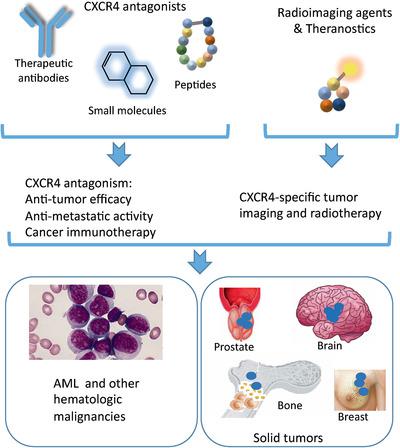当前位置:
X-MOL 学术
›
J. Leukoc. Biol.
›
论文详情
Our official English website, www.x-mol.net, welcomes your feedback! (Note: you will need to create a separate account there.)
At the Bedside: Profiling and treating patients with CXCR4‐expressing cancers
Journal of Leukocyte Biology ( IF 5.5 ) Pub Date : 2020-10-22 , DOI: 10.1002/jlb.5bt1219-714r Miguel Martin 1 , Ingrid A. Mayer 2 , Annemiek M.E. Walenkamp 3 , Constantin Lapa 4 , Michael Andreeff 5 , Alexandra Bobirca 6
Journal of Leukocyte Biology ( IF 5.5 ) Pub Date : 2020-10-22 , DOI: 10.1002/jlb.5bt1219-714r Miguel Martin 1 , Ingrid A. Mayer 2 , Annemiek M.E. Walenkamp 3 , Constantin Lapa 4 , Michael Andreeff 5 , Alexandra Bobirca 6
Affiliation

|
The chemokine receptor, C‐X‐C chemokine receptor type 4 (CXCR4) and its ligand, C‐X‐C motif chemokine 12, are key mediators of hematopoietic cell trafficking. Their roles in the proliferation and metastasis of tumor cells, induction of angiogenesis, and invasive tumor growth have been recognized for over 2 decades. CXCR4 is a promising target for imaging and therapy of both hematologic and solid tumors. To date, Sanofi Genzyme's plerixafor is the only marketed CXCR4 inhibitor (i.e., Food and Drug Administration‐approved in 2008 for stem cell mobilization). However, several new CXCR4 inhibitors are now being investigated as potential therapies for a variety of fluid and solid tumors. These small molecules, peptides, and Abs include balixafortide (POL6326, Polyphor), mavorixafor (X4P‐001, X4 Pharmaceuticals), motixafortide (BL‐8040, BioLineRx), LY2510924 (Eli Lilly), and ulocuplumab (Bristol‐Myers Squibb). Early clinical evidence has been encouraging, for example, with motixafortide and balixafortide, and the CXCR4 inhibitors appear to be generally safe and well tolerated. Molecular imaging is increasingly being used for effective patient selection before, or early during CXCR4 inhibitor treatment. The use of radiolabeled theranostics that combine diagnostics and therapeutics is an additional intriguing approach. The current status and future directions for radioimaging and treating patients with CXCR4‐expressing hematologic and solid malignancies are reviewed. See related review ‐ At the Bench: Pre‐Clinical Evidence for Multiple Functions of CXCR4 in Cancer. J. Leukoc. Biol. xx: xx–xx; 2020.
中文翻译:

在床边:对表达CXCR4的癌症患者进行分析和治疗
趋化因子受体C–X–C型趋化因子受体4(CXCR4)及其配体C–X–C基序趋化因子12是造血细胞运输的关键介质。人们已经认识到它们在肿瘤细胞的增殖和转移,诱导血管生成和侵袭性肿瘤生长中的作用已超过20年。CXCR4是血液学和实体瘤成像和治疗的有希望的靶标。迄今为止,赛诺菲健酶公司的plerixafor是唯一上市的CXCR4抑制剂(即,美国食品药品管理局于2008年批准用于干细胞动员)。但是,目前正在研究几种新的CXCR4抑制剂作为治疗各种液体和实体瘤的潜在疗法。这些小分子,肽和Abs包括balixafortide(POL6326,Polyphor),mavorixafor(X4P‐001,X4 Pharmaceuticals),motixafortide(BL‐8040,BioLineRx),LY2510924(礼来)和ulocuplumab(Bristol-Myers Squibb)。早期的临床证据令人鼓舞,例如使用莫替沙夫特和百利沙特,CXCR4抑制剂通常是安全且耐受性良好的。分子成像越来越多地用于CXCR4抑制剂治疗之前或治疗早期的有效患者选择。结合诊断和治疗方法使用放射性标记的治疗方法是另一种引人入胜的方法。回顾了放射成像和治疗具有CXCR4表达的血液系统和实体恶性肿瘤患者的现状和未来方向。请参阅相关评论‐替补席:CXCR4在癌症中具有多种功能的临床前证据。与莫替卡福特和百利沙特联合使用,CXCR4抑制剂通常是安全且耐受性良好的。分子成像越来越多地用于CXCR4抑制剂治疗之前或治疗早期的有效患者选择。结合诊断和治疗方法使用放射性标记的治疗方法是另一种引人入胜的方法。回顾了放射成像和治疗具有CXCR4表达的血液系统和实体恶性肿瘤患者的现状和未来方向。请参阅相关评论‐替补席:CXCR4在癌症中具有多种功能的临床前证据。与莫替卡福特和百利沙特联合使用,CXCR4抑制剂通常是安全且耐受性良好的。分子成像越来越多地用于CXCR4抑制剂治疗之前或治疗早期的有效患者选择。结合诊断和治疗方法使用放射性标记的治疗方法是另一种引人入胜的方法。回顾了放射成像和治疗具有CXCR4表达的血液系统和实体恶性肿瘤患者的现状和未来方向。请参阅相关评论‐替补席:CXCR4在癌症中具有多种功能的临床前证据。结合诊断和治疗方法使用放射性标记的治疗方法是另一种引人入胜的方法。回顾了放射成像和治疗具有CXCR4表达的血液系统和实体恶性肿瘤患者的现状和未来方向。请参阅相关评论‐替补席:CXCR4在癌症中具有多种功能的临床前证据。结合诊断和治疗方法使用放射性标记的治疗方法是另一种引人入胜的方法。回顾了放射成像和治疗具有CXCR4表达的血液系统和实体恶性肿瘤患者的现状和未来方向。请参阅相关评论‐替补席:CXCR4在癌症中具有多种功能的临床前证据。J.洛伊科(J. Leukoc)。生物学。xx:xx–xx;2020年。
更新日期:2020-10-22
中文翻译:

在床边:对表达CXCR4的癌症患者进行分析和治疗
趋化因子受体C–X–C型趋化因子受体4(CXCR4)及其配体C–X–C基序趋化因子12是造血细胞运输的关键介质。人们已经认识到它们在肿瘤细胞的增殖和转移,诱导血管生成和侵袭性肿瘤生长中的作用已超过20年。CXCR4是血液学和实体瘤成像和治疗的有希望的靶标。迄今为止,赛诺菲健酶公司的plerixafor是唯一上市的CXCR4抑制剂(即,美国食品药品管理局于2008年批准用于干细胞动员)。但是,目前正在研究几种新的CXCR4抑制剂作为治疗各种液体和实体瘤的潜在疗法。这些小分子,肽和Abs包括balixafortide(POL6326,Polyphor),mavorixafor(X4P‐001,X4 Pharmaceuticals),motixafortide(BL‐8040,BioLineRx),LY2510924(礼来)和ulocuplumab(Bristol-Myers Squibb)。早期的临床证据令人鼓舞,例如使用莫替沙夫特和百利沙特,CXCR4抑制剂通常是安全且耐受性良好的。分子成像越来越多地用于CXCR4抑制剂治疗之前或治疗早期的有效患者选择。结合诊断和治疗方法使用放射性标记的治疗方法是另一种引人入胜的方法。回顾了放射成像和治疗具有CXCR4表达的血液系统和实体恶性肿瘤患者的现状和未来方向。请参阅相关评论‐替补席:CXCR4在癌症中具有多种功能的临床前证据。与莫替卡福特和百利沙特联合使用,CXCR4抑制剂通常是安全且耐受性良好的。分子成像越来越多地用于CXCR4抑制剂治疗之前或治疗早期的有效患者选择。结合诊断和治疗方法使用放射性标记的治疗方法是另一种引人入胜的方法。回顾了放射成像和治疗具有CXCR4表达的血液系统和实体恶性肿瘤患者的现状和未来方向。请参阅相关评论‐替补席:CXCR4在癌症中具有多种功能的临床前证据。与莫替卡福特和百利沙特联合使用,CXCR4抑制剂通常是安全且耐受性良好的。分子成像越来越多地用于CXCR4抑制剂治疗之前或治疗早期的有效患者选择。结合诊断和治疗方法使用放射性标记的治疗方法是另一种引人入胜的方法。回顾了放射成像和治疗具有CXCR4表达的血液系统和实体恶性肿瘤患者的现状和未来方向。请参阅相关评论‐替补席:CXCR4在癌症中具有多种功能的临床前证据。结合诊断和治疗方法使用放射性标记的治疗方法是另一种引人入胜的方法。回顾了放射成像和治疗具有CXCR4表达的血液系统和实体恶性肿瘤患者的现状和未来方向。请参阅相关评论‐替补席:CXCR4在癌症中具有多种功能的临床前证据。结合诊断和治疗方法使用放射性标记的治疗方法是另一种引人入胜的方法。回顾了放射成像和治疗具有CXCR4表达的血液系统和实体恶性肿瘤患者的现状和未来方向。请参阅相关评论‐替补席:CXCR4在癌症中具有多种功能的临床前证据。J.洛伊科(J. Leukoc)。生物学。xx:xx–xx;2020年。


























 京公网安备 11010802027423号
京公网安备 11010802027423号